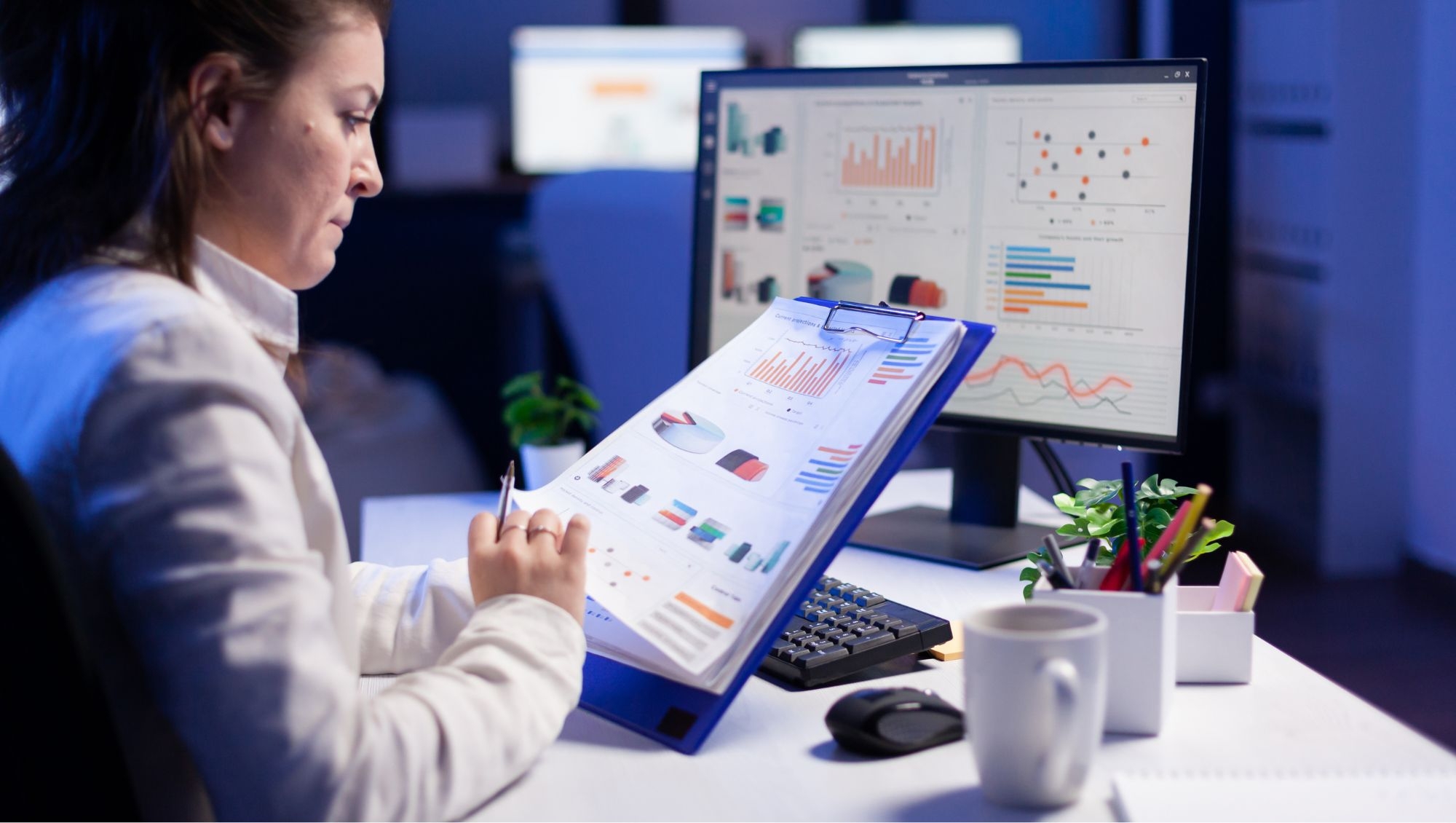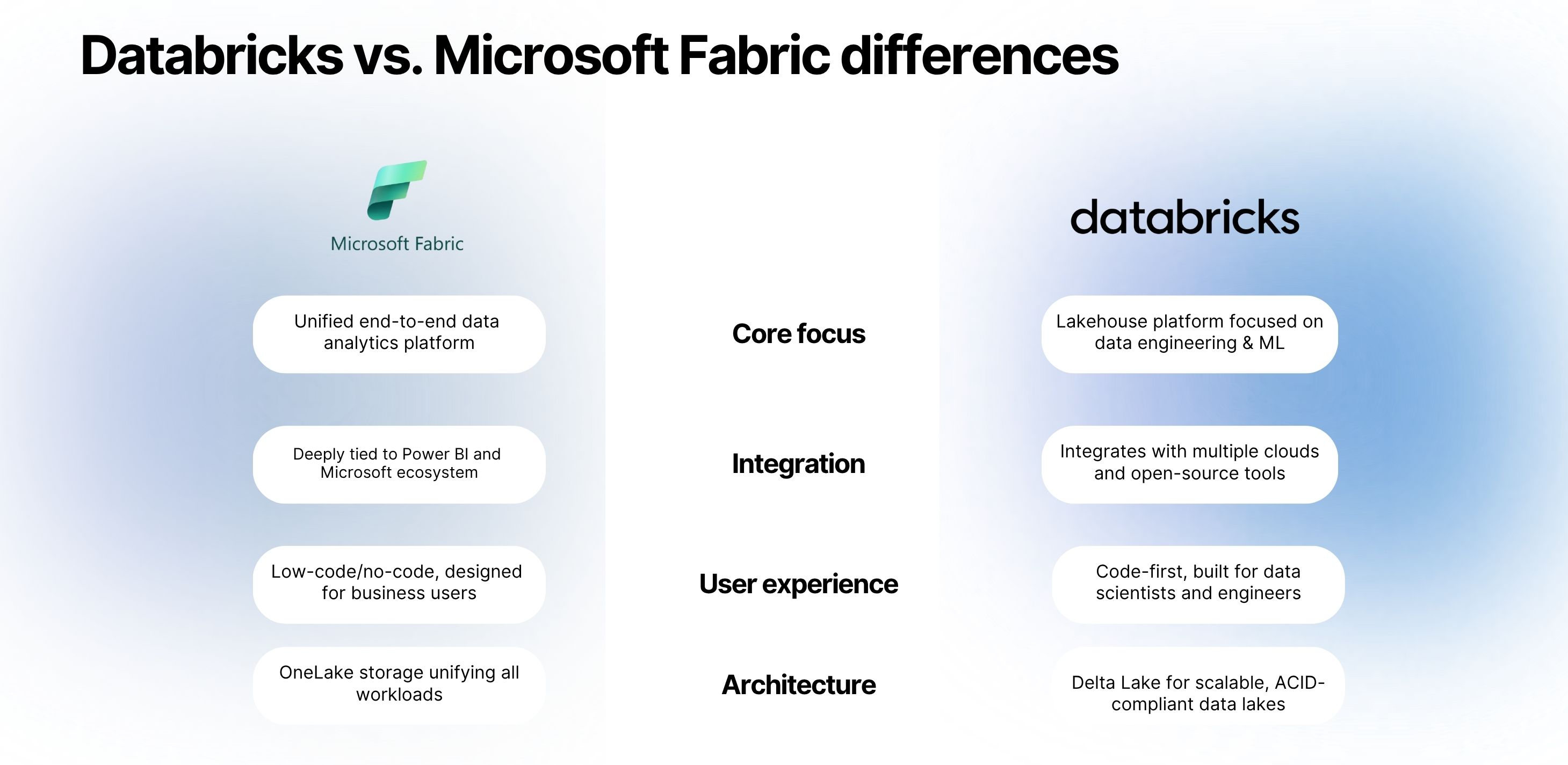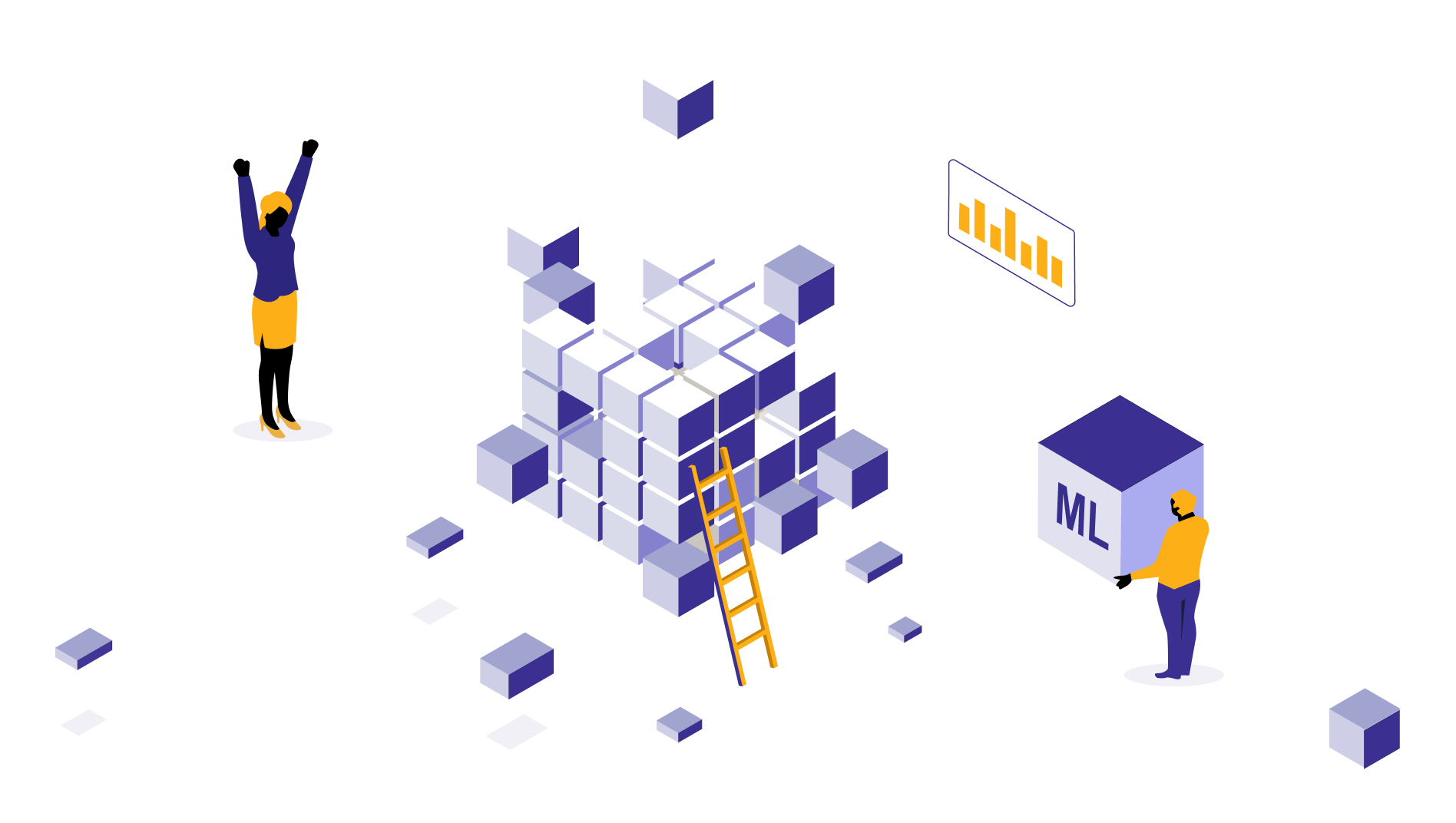Microsoft Fabric vs Databricks: A detailed comparison
Two tools: Microsoft Fabric vs Databricks. what's the most suitable analytics platform and why? Their core features and who can use them. Should you shift from Databricks to Fabric? Our senior data engineer, with expertise in both, and has shared his straightforward responses here.

Kannabiran
Jan 6, 2026 |
10 mins

What is Microsoft Fabric?
Released in 2023, Microsoft Fabric is a SaaS-native unified data platform built on top of its existing services: Azure Synapse, Power BI, and pipelines. The tool is mainly for companies that don’t want to juggle multiple tools, licenses, and ownerships, having everything in one place – from ingestion to AI. Storage is taken care of by OneLake, a central location for all organization data. With AI-powered tools and experiences, the tool is already making waves within a few years of its release, especially preferred a lot by existing Microsoft users.
What is Databricks?
Released in 2013, Databricks is also an analytics + warehousing + data transformation platform built on top of Apache Spark. The tool comprises of data engineering, real-time analytics, centralized governance, pipelines, and machine learning, along with collaborative work features. While Microsoft Fabric’s major purpose is to unify teams and data, Databricks mainly aims to make big data processing, advanced analytics, and ML flow seamless.
Microsoft Fabric vs Databricks
If seen from outside, both Databricks and Fabric are similar data platforms with overlapping and a few contrasting features. Following is a detailed comparison table of Microsoft Fabric vs Databricks, which helps you understand and select better.

Factors | Databricks | Microsoft Fabric |
|---|---|---|
Components and infrastructure | All-in-one SaaS platform. No infrastructure challenges. Simplified interface where user experience is prioritized. | Data and AI platform brought together using open-source based platforms. Requires more engineering finesse to operate. |
Processing | Comes with distributed processing engine for batch and stream processing. | |
Interface | Code based interface, which either demands Scala, Python, or SQL knowledge for Notebook based development. | SaaS based platform and no code/low code with pro dev tools. Also supports Spark Notebooks. |
Data engineering and pipelines | Comes with Data Factory to build pipelines just by dragging and dropping. Also, provisions Spark-based Lakehouse for data transformations. Fabric’s pipelines are still maturing, when compared to Databricks. | Has its native ETL/ELT pipelines and customizable orchestration, which are scalable. |
Real-time analytics | Synapse supports real-time data refreshes, allowing you to access reports as instantly as possible (with negligible delays). | Supports streaming data processing and real-time ingestion with Spark and Delta live tables. |
ML and AI | Has AI use cases like Copilot and data activator. ML capabilities still evolving, currently you can import ML models, run models using Pandas, sklearn, or connect Azure ML for higher workloads. If your company’s goals revolve around vivid analytics and dashboards and are building only simple predictive models, Microsoft Fabric, along with Azure ML will suit your company. | ML flow for full ML lifecycle management from versioning to experiment tracking. Auto ML to generate baseline models. Offers multi-learning and deep learning support. Databricks offers a matured infrastructure to data science and AI workloads, making it suitable for companies who need full-fledged MLOps support, retrainable workflows, and scalable model building. |
Governance and security | Fabric has Microsoft Purview for unified governance. It also comes with Azure’s active directory, lineage, RBAC, row and column level security, ensuring safe data access for compliant heavy industries. | Has security features like access control, data masking, lineage, etc. Also has introduced unity cataloguing. Though Databricks has everything essential in security and governance aspects, it’s not as matured as Fabric. |
Reporting | Has Power BI as one of the core components. Can build interactive dashboards and reports on near-real-time data with minimal delay. | Integrates with Power BI, Tableau, Looker, and other BI tools. Doesn’t have built-in reporting tool like Fabric. |
Who it is for | Fabric is great for companies needing end-to-end analytics with minimal devops overhead, where business-ready reports can be served in real time with a few BI analysts alone. Or when your company is already in Microsoft ecosystem, M365 or Azure. | Databricks is suitable for your team is infra-savvy, needs multi-cloud flexibility, stream processing needs, and has advanced ML/AI workloads. Perfect for mature data teams with heavy data science workloads. |
Best for | Real-time analytics, interactive business visualizations and reports, business-friendly data processing with simplified UI. | Highly scalable event-driven architecture, real-time data processing, and high-level ML and AI workflows. |
Can I use Databricks with Microsoft Fabric?
Yes. You can use Databricks and Microsoft Fabric to build a comprehensive and powerful data platform. Here's how they both can work together.
Components | Integration scope | How it can work together |
|---|---|---|
Storage | Can access ADLS and OneLake together in Databricks. | Like any ADLS container, Fabric’s Azure Data Lake Gen 2 storage can be mounted on top of Databricks. |
ETL pipelines | Can use both Data factory as well as heavy processing capabilities from Databricks. | Run orchestration with Fabric’s Databricks using linked services. |
Dashboarding | Use Power BI for data from OneLake as well as Databricks | Power BI can build interactive, near-real-time reports for data from Fabric as well as delta table from Databricks. |
Security and Governance | Employ Purview or Azure RBAC for governance | A centralized access control and security workflows for data workloads of both platforms together. |
AI/ML workflows | Use Databricks for Hugging Face and ML flow and Power BI from Fabric for visualizations. | Works great when your models involve results presented in analytical and visual formats. |
Is Microsoft Fabric a good alternative to Databricks?
You are using Databricks and if you want to see Microsoft Fabric is a good alternative for Databricks, here’s the answer: the change entirely on your use case, team maturity, and what you're optimizing for. Both Fabric and Databricks have their own advantages and deciding what works depends on your requirements alone. Here's where both tools win.
Microsoft Fabric | Databricks |
|---|---|
Unified data experience without infra overhead. | Offers better orchestration and cluster optimization for large-scale, heavy performance workloads. |
Great, if you are already deeply invested in Microsoft ecosystem. | Suitable for companies that prefer polyglot development (SQL, Python, Scala, etc). |
Enables centralized governance | Is matured in terms of data science, ML, and LLMs – gives fine-grained control over compute and clusters. |
OneLake data storage and paraquet format storage that facilitates complex, real-time analytics. |
I’m Power BI user. Is it okay to go for Databricks?
Assuming that your requirements revolve around business intelligence workloads, and you are happy with transformation and analytics complexities available, you will not have to move to Databricks.
But if you want to go beyond regular transformations, need more data engineering control, or have plans to build advanced AI/ML applications, then you may consider moving to Databricks.
What to choose now? Bricks or Fabric?
The verdict, considering experiences in both tools?
If your team requires business users to fulfil their ad hoc as well as other analytics requirements without much developer involvement, then Fabric will be more suitable for you.
If you're building ML products, require deeper engineering control, or have high-volume, complex workloads, then Databricks may be a suitable solution.
There are many companies that are winning with both Fabric and Databricks as well. So, you can consider a hybrid option too, where you use Databricks for data processing and Power BI for visualizations.
Frequently asked questions
1. Is Databricks better than Synapse?
Yes. Databricks is better than Synapse, especially for complex data engineering workloads. Databricks has a few superior features like Spark based processing, ability to handle complex ML workloads, more control over code, clusters, and optimization.
But Synapse is also great. It’s perfect for SQL-first analytics, better integration with Azure and Microsoft ecosystems.
2. Power BI in Microsoft Fabric vs Databricks + Power BI
Power Bi works best with Microsoft Fabric than Databricks. With Fabric it works because there is tight semantic integration, fewer pipeline works, fast time to dashboarding, and tighter security and governance.
3. How does Microsoft Fabric handle Lakehouse architecture vs Databricks?
Both Microsoft Fabric and Databricks use Lakehouse architecture, but their philosophies are different. With Databricks, it’s more engineering-driven, where you design and own the architecture. It’s built to scale well, especially for heavy ML workloads. Fabric’s lakehouse is different from Databricks, as Microsoft made it platform-driven, keeping the focus on BI and analytics and governance (at least for now). So, if you choose Databricks or Fabric based on Lakehouse, then choose Databricks for depth and control or Fabric for its simplicity and self-service analytics.
4. Can we integrate Databricks with Microsoft Fabric?
Yes. You can very well integrate Databricks with Microsoft Fabric, using Databricks for engineering and ML workloads and Fabric for governance and BI, getting the best of both worlds.

by Kannabiran
Kannabiran, a senior and Lead Data Engineer at datakulture, has led the strategy and delivery of cost-effective, efficient data infrastructures for companies across industries. A strong advocate of metadata-driven architecture, he brings deep knowledge of modern data engineering concepts and tools, and actively shares this expertise through blogs, videos, and community conversations. He is also the driving force behind building our novel ETL framework, while also guiding and nurturing young data engineers and interns.



